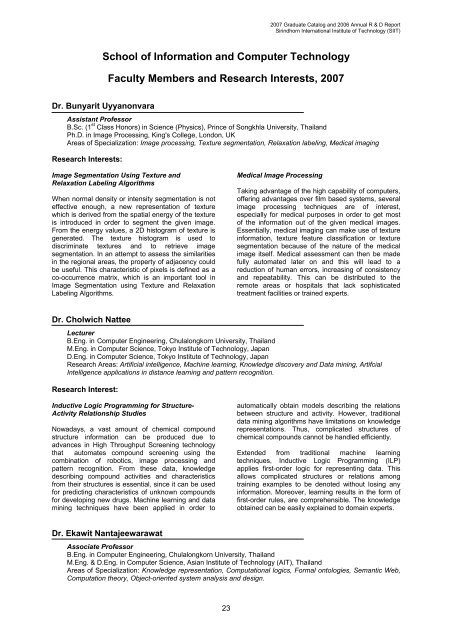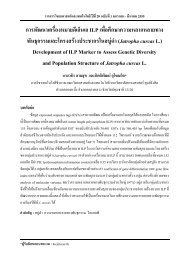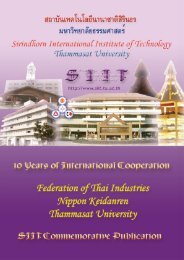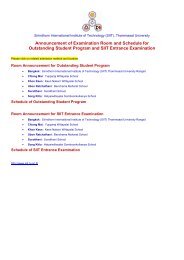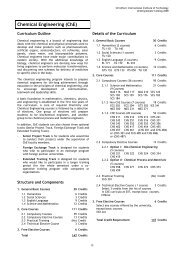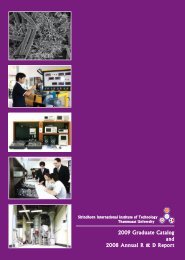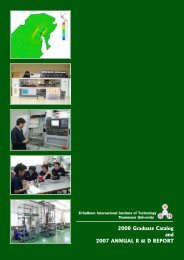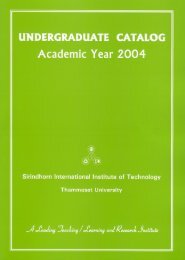2007 Graduate Catalog and 2006 Annual R & D Report - Sirindhorn ...
2007 Graduate Catalog and 2006 Annual R & D Report - Sirindhorn ...
2007 Graduate Catalog and 2006 Annual R & D Report - Sirindhorn ...
You also want an ePaper? Increase the reach of your titles
YUMPU automatically turns print PDFs into web optimized ePapers that Google loves.
<strong>2007</strong> <strong>Graduate</strong> <strong>Catalog</strong> <strong>and</strong> <strong>2006</strong> <strong>Annual</strong> R & D <strong>Report</strong><br />
<strong>Sirindhorn</strong> International Institute of Technology (SIIT)<br />
School of Information <strong>and</strong> Computer Technology<br />
Faculty Members <strong>and</strong> Research Interests, <strong>2007</strong><br />
Dr. Bunyarit Uyyanonvara<br />
Assistant Professor<br />
B.Sc. (1 st Class Honors) in Science (Physics), Prince of Songkhla University, Thail<strong>and</strong><br />
Ph.D. in Image Processing, King's College, London, UK<br />
Areas of Specialization: Image processing, Texture segmentation, Relaxation labeling, Medical imaging<br />
Research Interests:<br />
Image Segmentation Using Texture <strong>and</strong><br />
Relaxation Labeling Algorithms<br />
When normal density or intensity segmentation is not<br />
effective enough, a new representation of texture<br />
which is derived from the spatial energy of the texture<br />
is introduced in order to segment the given image.<br />
From the energy values, a 2D histogram of texture is<br />
generated. The texture histogram is used to<br />
discriminate textures <strong>and</strong> to retrieve image<br />
segmentation. In an attempt to assess the similarities<br />
in the regional areas, the property of adjacency could<br />
be useful. This characteristic of pixels is defined as a<br />
co-occurrence matrix, which is an important tool in<br />
Image Segmentation using Texture <strong>and</strong> Relaxation<br />
Labeling Algorithms.<br />
Medical Image Processing<br />
Taking advantage of the high capability of computers,<br />
offering advantages over film based systems, several<br />
image processing techniques are of interest,<br />
especially for medical purposes in order to get most<br />
of the information out of the given medical images.<br />
Essentially, medical imaging can make use of texture<br />
information, texture feature classification or texture<br />
segmentation because of the nature of the medical<br />
image itself. Medical assessment can then be made<br />
fully automated later on <strong>and</strong> this will lead to a<br />
reduction of human errors, increasing of consistency<br />
<strong>and</strong> repeatability. This can be distributed to the<br />
remote areas or hospitals that lack sophisticated<br />
treatment facilities or trained experts.<br />
Dr. Cholwich Nattee<br />
Lecturer<br />
B.Eng. in Computer Engineering, Chulalongkorn University, Thail<strong>and</strong><br />
M.Eng. in Computer Science, Tokyo Institute of Technology, Japan<br />
D.Eng. in Computer Science, Tokyo Institute of Technology, Japan<br />
Research Areas: Artificial intelligence, Machine learning, Knowledge discovery <strong>and</strong> Data mining, Artifcial<br />
Intelligence applications in distance learning <strong>and</strong> pattern recognition.<br />
Research Interest:<br />
Inductive Logic Programming for Structure-<br />
Activity Relationship Studies<br />
Nowadays, a vast amount of chemical compound<br />
structure information can be produced due to<br />
advances in High Throughput Screening technology<br />
that automates compound screening using the<br />
combination of robotics, image processing <strong>and</strong><br />
pattern recognition. From these data, knowledge<br />
describing compound activities <strong>and</strong> characteristics<br />
from their structures is essential, since it can be used<br />
for predicting characteristics of unknown compounds<br />
for developing new drugs. Machine learning <strong>and</strong> data<br />
mining techniques have been applied in order to<br />
automatically obtain models describing the relations<br />
between structure <strong>and</strong> activity. However, traditional<br />
data mining algorithms have limitations on knowledge<br />
representations. Thus, complicated structures of<br />
chemical compounds cannot be h<strong>and</strong>led efficiently.<br />
Extended from traditional machine learning<br />
techniques, Inductive Logic Programming (ILP)<br />
applies first-order logic for representing data. This<br />
allows complicated structures or relations among<br />
training examples to be denoted without losing any<br />
information. Moreover, learning results in the form of<br />
first-order rules, are comprehensible. The knowledge<br />
obtained can be easily explained to domain experts.<br />
Dr. Ekawit Nantajeewarawat<br />
Associate Professor<br />
B.Eng. in Computer Engineering, Chulalongkorn University, Thail<strong>and</strong><br />
M.Eng. & D.Eng. in Computer Science, Asian Institute of Technology (AIT), Thail<strong>and</strong><br />
Areas of Specialization: Knowledge representation, Computational logics, Formal ontologies, Semantic Web,<br />
Computation theory, Object-oriented system analysis <strong>and</strong> design.<br />
23


